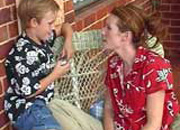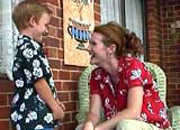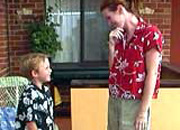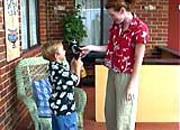Behaviour
Caring for babies
Bottle feeding
Changing a nappy
Cleaning and sterilising bottles
Daily cleaning tasks
Helping new children settle in
Preparing for a nappy change
Sleep patterns – babies
Sleep routines – babies
Toilet training
Caring for children
Allowing time for practice
Dressing/undressing
Mealtimes
Nappy change
Packing away/caring for the environment
Sleep/rest time
Toileting
Common self-help milestones
Tips for sleep and rest time
Self image
Communication
Body language
Limits and guidelines
Ways children communicate
Greeting children and families
Modelling appropriate communication
Questioning
Verbal and non–verbal communication
Acknowledging children's feelings
Listening attentively
Communicating with Aboriginal and Torres Strait Islander parents/carers
Development
Allowing time for practice
Dressing/undressing
Mealtimes
Nappy change
Packing away/caring for the environment
Sleep/rest time
Toileting
Common self-help milestones
Creative development
Language development
Modelling positive relationships
Physical development
Sharing and taking turns
Sleep patterns – babies
Sleep routines – babies
Encourage independent problem solving
Fundamental movement skills
Health, hygiene and safety
Coping with stress
Correct manual handling principles
Daily cleaning tasks
Hand washing
Hand washing poster
Manual handling overview
Toilet training
Safety checklist
Learning experiences and play
Environmentally friendly learning experiences
Learning experiences for different development areas
Creative resource materials
Arranging the environment to facilitate learning and pleasure
Indoors and outdoor areas
Creating a positive physical environment
Legal and ethical issues
Child abuse case studies
How do I recognise when a child or young person is at risk?
Tips on dealing with disclosures
Observation methods
Arranging Experiences (PDF 351Kb)
Recording observations
Rules for making observations
What you can learn from observations
Programming
Children’s interests, strengths, needs and skills
Extending the children’s interest in dinosaurs
Objective observation
Planning an OSHC environment
Behavior management plan
Planning enjoyable experiences
Planning experiences for 0 - 2 years age group
Planning experiences for 2 - 3 years age group
Planning experiences for 3 - 5 years age group
Modelling appropriate communication
By having a positive and attentive approach to caring for children, you are already beginning to demonstrate a respectful approach. By making yourself available to the children and taking an active role in their interests you will be well on your way to being a respectful communicator. By being accessible you will be available for the child to approach you whenever they feel the need. There are many ways you can make yourself accessible to the children.
Turn to face the child when they communicate

When a child is communicating with you, always turn to face the child. This demonstrates your positive interest and role models respectful communication as you listen to the child. By facing the child as they speak, you will also be more likely to pick up non-verbal cues such as facial expressions.
Go down to a child's physical level when you communicate

When communicating with a child, you should always move down to their physical level. This is a great way of demonstrating that you consider the child an equal, and that you are willing to engage in communication together. Standing over a child when they're talking to you could make them feel intimidated. Moving down to the child's level is a way of role modelling equality and respect.
Never ignore or pass over a child

Children (just like adults) like to feel valued. Ignoring or passing over a child when they're trying to interact with you is like sending a signal that says, 'I'm not interested in you'. Whatever you're doing, always make time to pay attention to a child. This role models respect for others.
Always stay within sight or hearing range

When a child is communicating or interacting with you, it is important that they feel you are interested in their interests or concerns. Always stay within visual and hearing range, so you can see and hear what they're communicating. By role modelling respect for others in this way, you are providing an excellent example for others to follow.
Remember to treat children the way that you would like to be treated. Children are like sponges - they absorb everything.
Did you know that you're a super model? Not the fashion model type, but a model of appropriate behaviour for the children you care for.
Remember, children are very impressionable - they will be watching everything you do and say very closely. As they watch you interact and communicate with the people in your centre, they will be learning from the skills you demonstrate. Be aware of this responsibility you have as a role model, and make sure that you are modelling the types of behaviours that you want the children to develop.